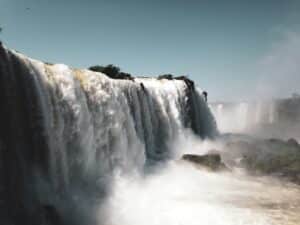Brazil is home to one of the world’s largest and most magnificent waterfalls, known as the Iguazu Falls. Located in the Iguazu National Park, on the border of the Brazilian state of Paraná and the Argentine province of Misiones, these falls attract millions of visitors each year.

The Iguazu Falls
have a rich history. The first recorded discovery of the falls dates back to 1541, when Spanish conquistador Álvar Núñez Cabeza de Vaca stumbled upon them while exploring the region. However, the falls were already considered a sacred site by the indigenous Guarani people, who believed that the gods had created them as a barrier to protect their land. The powerful spray of the cascading waters was seen as a sign of divine presence.
For centuries, the Iguazu Falls remained relatively unknown to the outside world. It wasn’t until the late 19th century, with the construction of a bridge across the Iguazu River, that they gained widespread attention. This increased accessibility sparked interest from explorers and tourists. In 1939, the Iguazu National Park was established to protect the falls and the surrounding forest, which was later recognized as a UNESCO World Heritage site in 1986.
The Iguazu Falls are a natural wonder consisting of over 270 individual cascades spread across a 2.7 km (1.7 miles) wide cliff. The most impressive of these cascades is the Devil’s Throat, a U-shaped chasm that measures 80 meters (262 feet) high and 150 meters (492 feet) wide. With its immense power and beauty, the Iguazu Falls have earned recognition as one of the New Seven Wonders of Nature.
Today, the Iguazu Falls remain one of Brazil’s top tourist destinations, drawing millions of visitors each year. The falls are easily accessible, with well-developed infrastructure and various tour options, including hiking trails, boat tours, and helicopter rides. The “Gran Aventura” boat tour is particularly popular, taking visitors on a thrilling journey into the heart of the falls, where they can experience the powerful spray of the cascading waters.
Aside from their stunning beauty, the Iguazu Falls also play a critical role in the region’s hydroelectric power generation and ecosystem preservation. The falls are an important source of power, and the surrounding forests are home to a diverse array of wildlife, including jaguars, monkeys, and toucans. Visitors can explore the Iguazu National Park, which encompasses the falls and the surrounding forest, to experience this rich biodiversity.
Whether you’re a nature lover, an adventure seeker, or simply someone looking for a breathtaking experience, a visit to the Iguazu Falls is a must. So pack your bags, grab your cameras, and head to Brazil to witness the stunning beauty of the country’s largest waterfall.
In conclusion, the Iguazu Falls in Brazil are a natural wonder that showcases the country’s beauty and diversity. With a rich history, recognition as a UNESCO World Heritage site, and a range of tourist attractions, the Iguazu Falls are a destination that appeals to history enthusiasts and nature lovers alike. Don’t wait any longer; plan your trip to Brazil today and discover the largest waterfall in the country!








